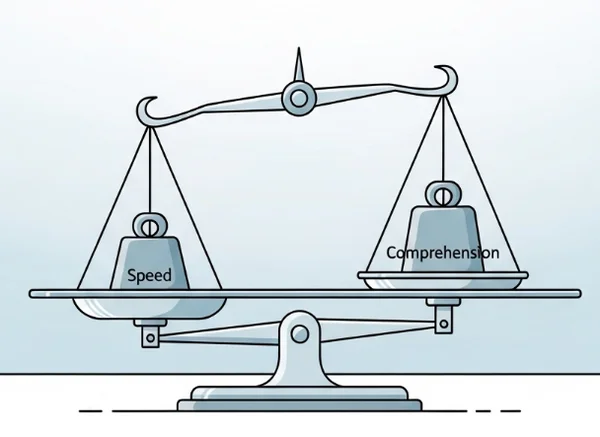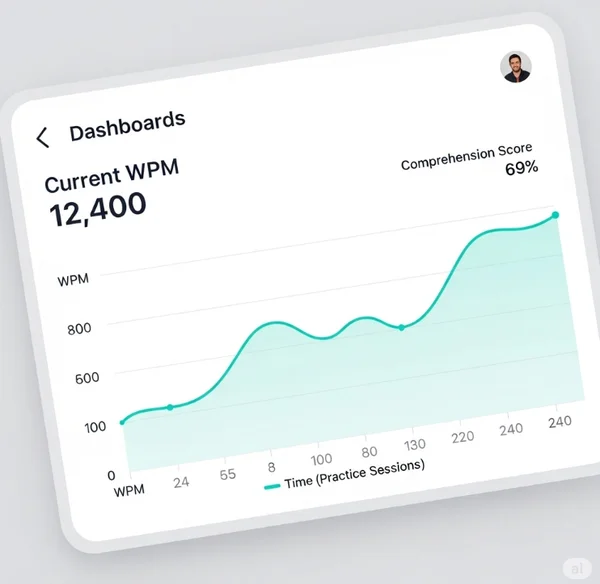Stop Subvocalization: Read Faster & Boost WPM
Do you ever find yourself silently "sounding out" words in your head as you read? If so, you're not alone. This common habit, known as subvocalization, can significantly slow down your reading speed test results. How can I improve my reading speed and comprehension? By mastering techniques to reduce this inner voice, you can unlock your reading potential and genuinely read faster. Ready to transform how you read? Start by exploring effective strategies on our platform. Discover your current reading pace and begin your journey to enhanced reading efficiency with a free reading speed test.

What is Subvocalization and Why Does it Limit Speed?
Subvocalization is the subtle process of pronouncing words in your mind as you read. While it's a natural part of learning to read, it can become a silent barrier to achieving higher reading speeds. Understanding this fundamental aspect of reading is crucial for anyone aiming to improve their reading efficiency.
The "Inner Voice": How We Read Aloud in Our Heads
From childhood, we're taught to sound out words to understand them. This practice often internalizes into what we call the "inner voice." Even when reading silently, many people's brains still process words as if they were speaking them. This internal dialogue means your reading speed is capped by your speaking speed, which is significantly slower than your brain's capacity to process information. For ambitious students, overwhelmed professionals, and lifelong learners, this limitation can severely impact productivity.
The Silent Barrier: From Early Habits to Slow WPM
This habit, while helpful in early literacy, transforms into a silent barrier as you mature as a reader. Your eye can scan words far quicker than your mouth can pronounce them, even internally. When you subvocalize, you force your reading speed to match your internal speaking rate, typically between 150-250 words per minute (WPM). To achieve a higher average reading speed, or even excel beyond it, you must learn to decouple your reading from this internal speaking process. This is the first critical step toward boosting your WPM and improving your information processing.
Practical Exercises to Reduce Inner Voice & Read Faster
Overcoming subvocalization requires conscious effort and consistent practice. These practical exercises are designed to help you reduce inner voice and read faster without sacrificing comprehension. They focus on retraining your brain to process text visually rather than audibly.
The Hum or Chew Method: Distracting Your Inner Narrator
One of the simplest ways to disrupt your internal narrator is to give your mouth something else to do. Try the hum or chew method. As you read, gently hum a tune, chew gum, or silently move your tongue around your mouth. This occupies the parts of your brain typically used for subvocalization, forcing your eyes and brain to process words visually. It might feel awkward at first, but with practice, you'll find your brain adapting to this new way of reading. This exercise helps break the ingrained habit and allows you to experience silent reading more effectively.
Pacing Techniques: Using a Timer or Metronome for Speed
To actively push your reading speed beyond your subvocalization limit, employ pacing techniques. Use a timer, a metronome, or even a simple finger guide to set a faster-than-comfortable pace. Set a timer for one minute and try to read as much as possible. With a metronome, try to read a line or a paragraph per beat, gradually increasing the tempo. The goal is to train your eyes to move faster across the page, giving your inner voice less time to "speak" each word. Consistent use of a reading pace calculator can help you quantify this progress.

Expanding Your Visual Span: Seeing More Words at Once
Subvocalization often encourages reading word-by-word. To overcome this, focus on expanding your visual span. Instead of focusing on individual words, try to read groups of 2-3 words at a time. Practice looking at the center of a three-word phrase and absorbing all of them simultaneously. This is a core speed reading technique that reduces the need for your inner voice to articulate each word separately. Many find that looking at text without focusing on specific words allows them to take in more information with each glance, thereby improving their overall reading comprehension test performance.
Mastering Silent Reading: Balancing Speed with Comprehension
The ultimate goal of reducing subvocalization is not just speed, but effective, silent reading that balances speed with strong comprehension. True reading mastery means understanding and retaining information efficiently.

Active Reading Strategies Without Your Inner Voice
Once you begin to lessen your inner voice, incorporate active reading strategies to ensure deep comprehension. This includes asking questions before, during, and after reading; mentally summarizing paragraphs; and identifying key arguments. Without the distraction of internal pronunciation, your brain can dedicate more processing power to understanding the text's meaning. These techniques, when combined with reduced subvocalization, contribute significantly to your overall reading efficiency and comprehension skills.
When is Subvocalization Okay? (And When is it Not?)
It's important to understand that complete elimination of subvocalization isn't always necessary, or even possible, for everyone. Sometimes, a subtle internal voice can aid in understanding complex or highly technical material, or when you're proofreading. The key is to control it. For most general reading, particularly large volumes of text (like reports, articles, or leisure books), reducing subvocalization is highly beneficial. However, for poetry, dense academic papers, or highly technical documents where precision is paramount, allowing a slight inner voice can enhance understanding. The goal is intentional use, not absolute eradication.
Track Your Progress: See Your WPM Soar!
Learning to stop subvocalization is a skill that improves with consistent practice. The best way to stay motivated and refine your techniques is to track your progress and see how your WPM test results soar!
The Importance of Regular Practice and Testing
Just like any other skill, improving your reading speed requires regular practice and testing. Dedicate short, consistent periods each day to applying these techniques. Whether it's 10-15 minutes with a book or an article, consistency is key. The more you train your brain to read visually and reduce your inner voice, the more natural it becomes. Think of it as reading practice for your brain; the more you do it, the stronger your comprehension skills become.
Measuring Improvement with Our Reading Speed Test
At Reading Speed Test, we provide a free, easy-to-use platform that not only measures your words per minute (WPM) but also assesses your comprehension. After applying the techniques discussed, simply start your reading speed test on our homepage. You'll read a passage, answer a few comprehension questions, and instantly receive a detailed report showing your WPM and understanding score. This dual assessment is critical for ensuring you're not just reading fast, but reading effectively. Our platform is the perfect companion for your journey to read faster and smarter.

Conclusion: Your Journey to Faster, More Efficient Reading Starts Now
Overcoming subvocalization is a powerful step towards becoming a more efficient and effective reader. By understanding the "inner voice" and actively practicing techniques to reduce inner voice, you can significantly boost your reading speed and improve your comprehension. This change will empower you, whether you're a student tackling textbooks, a professional sifting through reports, or a lifelong learner hungry for new knowledge.
Your journey to faster, more efficient reading is within reach. Don't let old habits hold you back. Begin by applying these strategies, practicing consistently, and most importantly, measuring your progress. Ready to uncover your reading potential? Take the ultimate reading speed test today and see how much your WPM and comprehension can truly soar!
Subvocalization & Speed Reading: Your Questions Answered
How to stop subvocalization when reading?
To stop subvocalization when reading, practice techniques like the hum or chew method to distract your internal voice, use a pacer (like your finger or a metronome) to increase your reading speed, and actively work on expanding your visual span to read multiple words at once. Consistent practice with these speed reading techniques will gradually reduce the habit.
Is it possible to read without any inner voice at all?
While it's very difficult to eliminate the inner voice entirely, especially for highly complex material, it is possible to significantly reduce its impact for most types of reading. The goal isn't necessarily zero subvocalization, but rather to minimize it to the point where it no longer limits your reading pace.
How long does it take to eliminate subvocalization?
The time it takes to reduce inner voice varies for each individual, depending on consistency of practice and the strength of the habit. With regular, focused effort (10-15 minutes daily), you can start noticing improvements in a few weeks to a few months. Remember, it's a skill that builds over time with dedicated reading practice.
Does eliminating subvocalization guarantee higher comprehension?
No, simply eliminating subvocalization does not automatically guarantee higher reading comprehension test scores. While it removes a speed bottleneck, maintaining and improving comprehension requires active reading strategies, focus, and engagement with the material. Our free reading speed test provides both WPM and comprehension scores to help you balance both effectively.